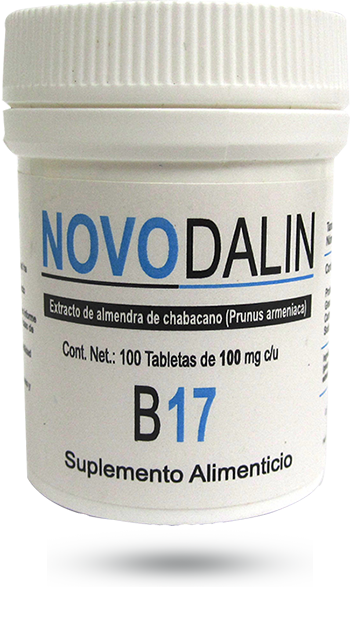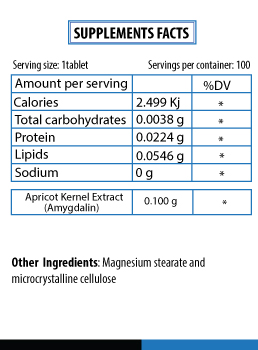COVID-19: On behalf of Novodalin, we wanted to thank you for your loyalty. Please note that for the moment you may receive your 500mg and the 100mg Amygdalin Tablets in a different type of bottle. This measure is only temporaly. More Details.
Novodalin 100mg Tablets

Each Novodalin 100 mg tablet contains:
| Amygdalin | 100mg |
| Microcrystalline Cellulose | 76.3mg |
| Magnesium Stearate | 5.5 |
Amygdalin: Our active ingredient, it is pure Vitamin B17 extracted from Apricot Kernels (P. Armeniaca) with a purity of 99.5% it is a very stable compound with a melting point of 200°C - 220°C, pH in saturated water solution about 7.
Microcrystalline Cellulose: used as a filler is incorporated into the formulation to increase the size of the tablet in order to make it suitable for handling, our filler acts as a binder too, ensuring that the tablet can be formed with the required mechanical strength, holding it together to prevent it from breaking down during packaging, shipping and routine handling.
Magnesium stearate: used as a lubricant to ensure that the tableting powder does not adhere to the processing equipment, also to ensure that the flow of the powder mixes through the presses and minimize friction, we use Magnesium Stearate because Magnesium is a mineral that supports bone mineralization, heart function and many enzyme systems. Magnesium is essential to the body's use of glucose, which gives energy to the body.

Magnesium is essential to the body's use of glucose, which gives energy to the body. Magnesium is found abundantly in legumes, nuts, seafood, chocolate and green leafy vegetables, and in "hard" water. Our tablets are formed solely by our active ingredient, a filler and a lubricant, our active ingredient Amygdalin is an extract of the apricot kernels with a purity of 99.5% , white crystalline, bitter powder; our excipients are chosen among a range of excipients which have been appropriately evaluated for safety and are included in the delivery system to aid in the manufacture, protect, support, enhance stability, bioavailability and consumer acceptability.
Apricot sweet and bitter almonds.
Why bitter is better.
The origins of Apricot (Prunus Armeniaca) included in the genus Prunus in the subfamily Prunoideae in the family Rosaceae are the Central Asia, Western Asia, Iran and Caucasus. Apricot is quite a valuable fruit that can be processed into numerous different products. Not only apricot is consumed in fresh and dried forms throughout the year, but also the seeds of its kernels are utilized in various ways.
The bitter almond is slightly broader and shorter than the sweet almond, and contains about 50% of the fixed oil that occurs in sweet almonds.
Cooking oil, benzaldehyde, activated carbon, amygdalin and hydrocyanic acid are obtained from the seeds of apricot. The apricot kernels that are sweet are consumed as dried fruits, whereas those that are bitter are used as raw materials in cosmetic and pharmaceutical industries.
Known as a cyanogenic glycoside, amygdalin, D(-)-mandelonitrile -gentobioside, is found abundantly in many tissues, and especially seeds of species Prunus.
Apricot seeds contain various amounts of amygdalin depending on cultivars. It is reported that bitter contain higher amygdalin that sweet cultivars (Gomez et al., 1998). Femenia et al(1995) reported that a high amount of amygdalin
was found in bitter aprico cultivars, but not in seeds of sweet ones.
These differences in amygdalin content are considered to be due to the differences in the harvest time when the fruit was collected. As a matter of fact, Frehner et al. (1990) reported that the cyanogenic content of seeds might vary significantly throughout maturation and that an increase occurred with maturation in almond seeds.
The conclusion was that seeds of bitter cultivars contained quite a high level of amygdalin than seeds of sweet cultivars, in this case Paviot and Karacabey contained the highest amygdalin content among all apricot cultivars.